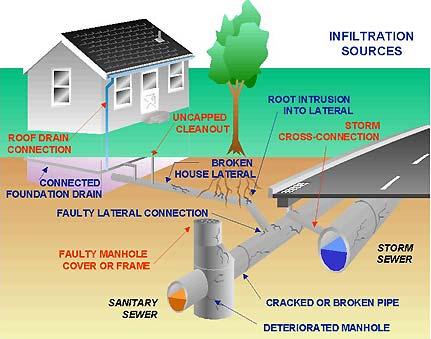

Design Sewage Flow
Design sewage flow is the expected maximum discharge in the sewer during the life of the system. This is arrived by multiplying the population expected at the end of the design period with the per capita sewage flow and a peak factor.
- Design Period
The length of time up to which the sewerage system will serve without any modification or addition, is referred to as the design period. The design period is based on the useful life of structures, machinery and the equipment to be employed, the ease or difficulty of expanding or increasing or addition of the facility. The design period for sewerage systems may be not less than 20 years and not more than 30 years (excluding construction period).
- Design Population
The design population is the population expected at the end of the design period and the sewerage system should be designed to serve for the design population. Design population may be estimated based on the census population of the town for the past decades considering all the factors governing the future growth and development of the area and using any one of the methods for population forecast. For details of methods of population forecast refer the book ‘Water Supply Engineering’ by this author.
Where Master plan containing land use pattern is available for the town, the anticipated population can be estimated based on the ultimate density of population and permitted floor space index and as per the land use plan in the Master plan. The design population of sewerage system may be the same as adopted in water supply project for the city. In the absence of such information on population, the density of population listed in below Table A may be adopted.
| Size of town (population) | Density of population per hectare | |
| Up to 5000 | 75 | -150 |
| 5000 to 20000 | 150 | -250 |
| 20000 to 50000 | 250 | -300 |
| 50000 to 100000 | 300 | -350 |
| Above 1000000 | 350 | -1000 |
Source: CPHEEO Manual. However, it is advisable to adopt the least of the forecast population based on the different methods, because over design of the components of sewerage system will adversely affect the performance of the system.
- Per capita Sewage Flow
As per the Manual on Sewerage and Sewage treatment (CPHEEO, GOI) 80% of the water supply may be expected to reach the sewers. However, the sewers for major cities and towns should be designed for a minimum sewage flow of 150 Lpcd and 100 Lpcd respectively. Industrial wastewaters have to be treated to the standard by the industries before discharging into the sewers.
- Peak Factor
The design flow of the sewerage system shall be the maximum hourly flow expected in the system or peak flow. The peak flow is the average hourly flow (expected at the end of the design period) multiplied by a peak factor, which depends on the population. The typical values of peak factors for different contributing population of the zone recommended, are shown in Table B
- Groundwater Infiltration
Estimate of flow in sanitary sewers may include certain flows due to infiltration of groundwater. through pipe joints and manholes. Addition of the storm flow to the design sewage flow is to be done only in situation where groundwater table is expected to raise the level of sewers. Suggested estimates for groundwater infiltration into sewers located below groundwater table are furnished in C
2 Responses to “Design Sewage Flow”
Leave a Reply









 LIKE TO GET UPDATES
LIKE TO GET UPDATES  TO GET EXPERT GUIDE
TO GET EXPERT GUIDE
Greetings I stumbled on your website by mistake when i searched Msn for chemical treatment subject, I have to express your page is quite helpful I also really like the style, it is wonderful!
I found it interesting when you said that the development of the area plays a role in designing wastewater. My uncle mentioned to me that they are planning to have a solution for the unsewered area in their community. Thanks to this informative article, I’ll be sure to tell him that it will be much better if they consult a wastewater design service as they can answer all their inquiries.